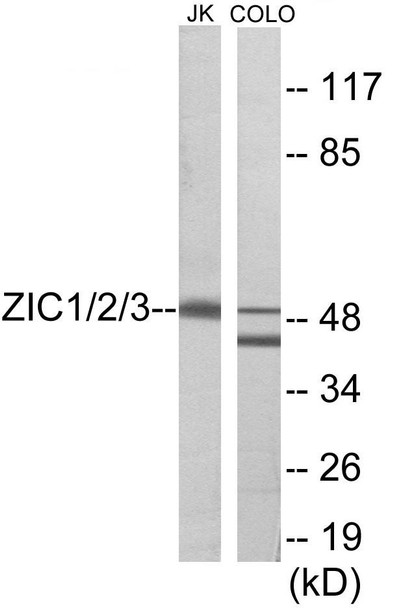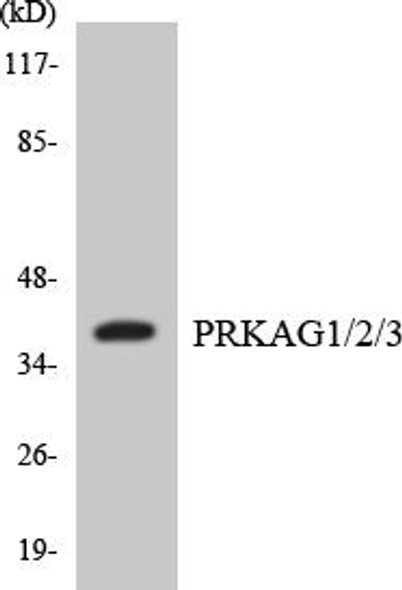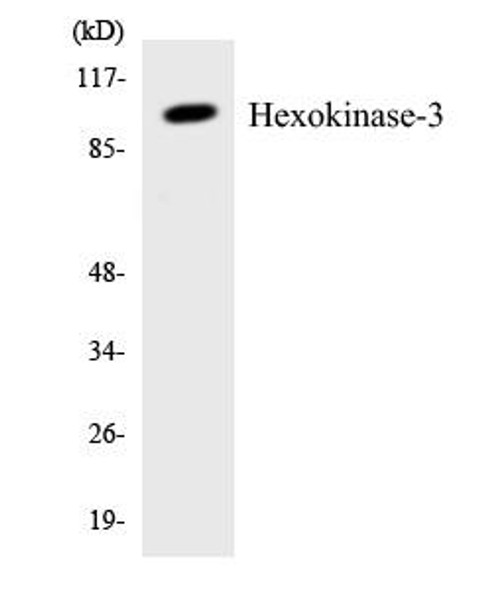Description
ZIC1/2/3 Colorimetric Cell-Based ELISA
The ZIC1/2/3 Colorimetric Cell-Based ELISA Kit is a powerful tool for researchers studying the ZIC family of transcription factors. This kit allows for the accurate and sensitive detection of ZIC1, ZIC2, and ZIC3 levels in cell lysates or tissue samples. With its high sensitivity and specificity, researchers can trust the results obtained with this kit for their experiments.The ZIC family of transcription factors plays a critical role in various developmental processes, including neural tube formation, cell differentiation, and organ development.
Dysregulation of these transcription factors has been implicated in various diseases, making them important targets for research and potential therapeutic interventions.Overall, the ZIC1/2/3 Colorimetric Cell-Based ELISA Kit is a valuable tool for researchers interested in studying the function and regulation of the ZIC family of transcription factors in both normal development and disease states.
| Product Name: | ZIC1/2/3 Colorimetric Cell-Based ELISA |
| Product Code: | CBCAB00940 |
| ELISA Type: | Cell-Based |
| Target: | ZIC1/2/3 |
| Reactivity: | Human, Mouse |
| Dynamic Range: | > 5000 Cells |
| Detection Method: | Colorimetric 450 nmStorage/Stability:4°C/6 Months |
| Format: | 96-Well Microplate |
The ZIC1/2/3 Colorimetric Cell-Based ELISA Kit is a convenient, lysate-free, high throughput and sensitive assay kit that can detect ZIC1/2/3 protein expression profile in cells. The kit can be used for measuring the relative amounts of ZIC1/2/3 in cultured cells as well as screening for the effects that various treatments, inhibitors (ie siRNA or chemicals), or activators have on ZIC1/2/3.
Qualitative determination of ZIC1/2/3 concentration is achieved by an indirect ELISA format. In essence, ZIC1/2/3 is captured by ZIC1/2/3-specific primary antibodies while the HRP-conjugated secondary antibodies bind the Fc region of the primary antibody. Through this binding, the HRP enzyme conjugated to the secondary antibody can catalyze a colorimetric reaction upon substrate addition. Due to the qualitative nature of the Cell-Based ELISA, multiple normalization methods are needed:
| 1. | A monoclonal antibody specific for human GAPDH is included to serve as an internal positive control in normalizing the target absorbance values. |
| 2. | Following the colorimetric measurement of HRP activity via substrate addition, the Crystal Violet whole-cell staining method may be used to determine cell density. After staining, the results can be analysed by normalizing the absorbance values to cell amounts, by which the plating difference can be adjusted. |
| Database Information: | Gene ID: 7545/7546/7547, UniProt ID: Q15915/O95409/O60481, OMIM: 600470/603073/609637/300265/306955, Unigene: Hs.598590/Hs.647962/Hs.653700/Hs.111227 |
| Gene Symbol: | ZIC1 |
| Sub Type: | None |
| UniProt Protein Function: | ZIC1: Acts as a transcriptional activator. Involved in neurogenesis. Plays important roles in the early stage of organogenesis of the CNS, as well as during dorsal spinal cord development and maturation of the cerebellum. Involved in the spatial distribution of mossy fiber (MF) neurons within the pontine gray nucleus (PGN). Plays a role in the regulation of MF axon pathway choice. Promotes MF migration towards ipsilaterally- located cerebellar territories. May have a role in shear flow mechanotransduction in osteocytes. Retains nuclear GLI1 and GLI3 in the cytoplasm. Binds to the minimal GLI-consensus sequence 5'- TGGGTGGTC-3'. Belongs to the GLI C2H2-type zinc-finger protein family. |
| UniProt Protein Details: | Protein type:DNA-binding; C2H2-type zinc finger protein; Transcription factor Chromosomal Location of Human Ortholog: 3q24 Cellular Component: nucleoplasm; nucleus Molecular Function:transcription factor activity Biological Process: brain development; inner ear morphogenesis; pattern specification process; positive regulation of protein import into nucleus; positive regulation of transcription, DNA-dependent; regulation of smoothened signaling pathway Disease: Craniosynostosis 6 |
| NCBI Summary: | This gene encodes a member of the ZIC family of C2H2-type zinc finger proteins. Members of this family are important during development. Aberrant expression of this gene is seen in medulloblastoma, a childhood brain tumor. This gene is closely linked to the gene encoding zinc finger protein of the cerebellum 4, a related family member on chromosome 3. This gene encodes a transcription factor that can bind and transactivate the apolipoprotein E gene. [provided by RefSeq, Jul 2008] |
| UniProt Code: | Q15915 |
| NCBI GenInfo Identifier: | 209572702 |
| NCBI Gene ID: | 7545 |
| NCBI Accession: | Q15915.2 |
| UniProt Secondary Accession: | Q15915,Q2M3N1, |
| UniProt Related Accession: | Q15915 |
| Molecular Weight: | 48,309 Da |
| NCBI Full Name: | Zinc finger protein ZIC 1 |
| NCBI Synonym Full Names: | Zic family member 1 |
| NCBI Official Symbol: | ZIC1 |
| NCBI Official Synonym Symbols: | ZIC; CRS6; ZNF201 |
| NCBI Protein Information: | zinc finger protein ZIC 1 |
| UniProt Protein Name: | Zinc finger protein ZIC 1 |
| UniProt Synonym Protein Names: | Zinc finger protein 201; Zinc finger protein of the cerebellum 1 |
| Protein Family: | Zinc finger protein |
| UniProt Gene Name: | ZIC1 |
| UniProt Entry Name: | ZIC1_HUMAN |
| Component | Quantity |
| 96-Well Cell Culture Clear-Bottom Microplate | 2 plates |
| 10X TBS | 24 mL |
| Quenching Buffer | 24 mL |
| Blocking Buffer | 50 mL |
| 15X Wash Buffer | 50 mL |
| Primary Antibody Diluent | 12 mL |
| 100x Anti-Phospho Target Antibody | 60 µL |
| 100x Anti-Target Antibody | 60 µL |
| Anti-GAPDH Antibody | 60 µL |
| HRP-Conjugated Anti-Rabbit IgG Antibody | 12 mL |
| HRP-Conjugated Anti-Mouse IgG Antibody | 12 mL |
| SDS Solution | 12 mL |
| Stop Solution | 24 mL |
| Ready-to-Use Substrate | 12 mL |
| Crystal Violet Solution | 12 mL |
| Adhesive Plate Seals | 2 seals |
The following materials and/or equipment are NOT provided in this kit but are necessary to successfully conduct the experiment:
- Microplate reader able to measure absorbance at 450 nm and/or 595 nm for Crystal Violet Cell Staining (Optional)
- Micropipettes with capability of measuring volumes ranging from 1 µL to 1 ml
- 37% formaldehyde (Sigma Cat# F-8775) or formaldehyde from other sources
- Squirt bottle, manifold dispenser, multichannel pipette reservoir or automated microplate washer
- Graph paper or computer software capable of generating or displaying logarithmic functions
- Absorbent papers or vacuum aspirator
- Test tubes or microfuge tubes capable of storing ≥1 ml
- Poly-L-Lysine (Sigma Cat# P4832 for suspension cells)
- Orbital shaker (optional)
- Deionized or sterile water
*Note: Protocols are specific to each batch/lot. For the correct instructions please follow the protocol included in your kit.
| Step | Procedure |
| 1. | Seed 200 µL of 20,000 adherent cells in culture medium in each well of a 96-well plate. The plates included in the kit are sterile and treated for cell culture. For suspension cells and loosely attached cells, coat the plates with 100 µL of 10 µg/ml Poly-L-Lysine (not included) to each well of a 96-well plate for 30 minutes at 37°C prior to adding cells. |
| 2. | Incubate the cells for overnight at 37°C, 5% CO2. |
| 3. | Treat the cells as desired. |
| 4. | Remove the cell culture medium and rinse with 200 µL of 1x TBS, twice. |
| 5. | Fix the cells by incubating with 100 µL of Fixing Solution for 20 minutes at room temperature. The 4% formaldehyde is used for adherent cells and 8% formaldehyde is used for suspension cells and loosely attached cells. |
| 6. | Remove the Fixing Solution and wash the plate 3 times with 200 µL 1x Wash Buffer for five minutes each time with gentle shaking on the orbital shaker. The plate can be stored at 4°C for a week. |
| 7. | Add 100 µL of Quenching Buffer and incubate for 20 minutes at room temperature. |
| 8. | Wash the plate 3 times with 1x Wash Buffer for 5 minutes each time. |
| 9. | Add 200 µL of Blocking Buffer and incubate for 1 hour at room temperature. |
| 10. | Wash 3 times with 200 µL of 1x Wash Buffer for 5 minutes each time. |
| 11. | Add 50 µL of 1x primary antibodies (Anti-ZIC1/2/3 Antibody and/or Anti-GAPDH Antibody) to the corresponding wells, cover with Parafilm and incubate for 16 hours (overnight) at 4°C. If the target expression is known to be high, incubate for 2 hours at room temperature. |
| 12. | Wash 3 times with 200 µL of 1x Wash Buffer for 5 minutes each time. |
| 13. | Add 50 µL of 1x secondary antibodies (HRP-Conjugated AntiRabbit IgG Antibody or HRP-Conjugated Anti-Mouse IgG Antibody) to corresponding wells and incubate for 1.5 hours at room temperature. |
| 14. | Wash 3 times with 200 µL of 1x Wash Buffer for 5 minutes each time. |
| 15. | Add 50 µL of Ready-to-Use Substrate to each well and incubate for 30 minutes at room temperature in the dark. |
| 16. | Add 50 µL of Stop Solution to each well and read OD at 450 nm immediately using the microplate reader. |
(Additional Crystal Violet staining may be performed if desired – details of this may be found in the kit technical manual.)






